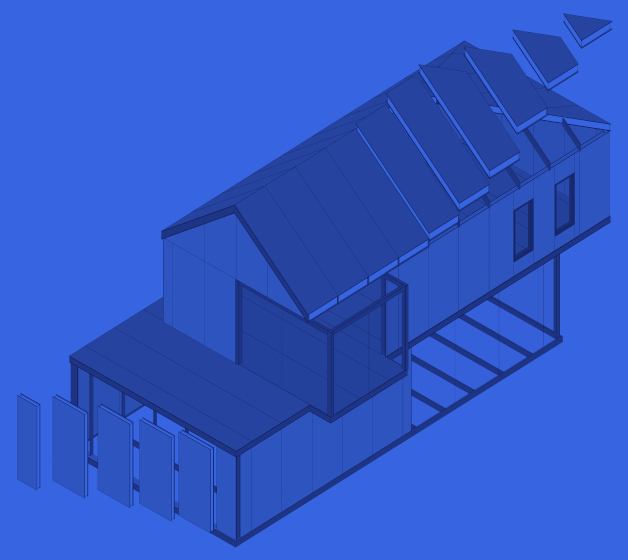 House building is an expensive long-term project that requires lots of planning in advance, with any mistakes that are made resulting in wasted time and additional expenses. The good news is that there is a way to avoid human error and build a house that is both eco-friendly and cost-effective. Using structural insulated panels (SIPs) not only enables you to assemble the structure as easy as a doll house at the construction site, but with the right software also speeds up other building phases like modelling, documentation, and fabrication.
House building is an expensive long-term project that requires lots of planning in advance, with any mistakes that are made resulting in wasted time and additional expenses. The good news is that there is a way to avoid human error and build a house that is both eco-friendly and cost-effective. Using structural insulated panels (SIPs) not only enables you to assemble the structure as easy as a doll house at the construction site, but with the right software also speeds up other building phases like modelling, documentation, and fabrication.
What are SIPs?
Most house builders go through the traditional motions of setting up traditional timber framing and insulation. But these guys obviously didn’t feel like dealing with stick-frames; they decided to stray from the rule book, get some SIP panels, and assemble a house in two weeks. Sounds almost like building with Legos, doesn’t it? The secret is that SIP panels already have both framing and insulation inside of them – a foam core sandwiched between two structural facings, typically oriented strand board (OSB).
 Speed. Building houses with SIPs is three times as fast as using wooden frames. The high strength-to-weight ratio of SIP panels allow large sections of your building to be fitted at once, reducing the time required on-site for construction. Erection times are also known in advance, so SIPs give you an accurate delivery date for your building. And since these panels are structural, fewer inner supporting walls are needed, allowing for a more open floor plan. Once the siding is installed, it is impossible to distinguish a SIP house from a conventionally framed one. Any style of house can be built with SIPs, whether traditional or highly modern.
Speed. Building houses with SIPs is three times as fast as using wooden frames. The high strength-to-weight ratio of SIP panels allow large sections of your building to be fitted at once, reducing the time required on-site for construction. Erection times are also known in advance, so SIPs give you an accurate delivery date for your building. And since these panels are structural, fewer inner supporting walls are needed, allowing for a more open floor plan. Once the siding is installed, it is impossible to distinguish a SIP house from a conventionally framed one. Any style of house can be built with SIPs, whether traditional or highly modern.
Sustainability. SIPs are a great option for those concerned about the environment. The panels produce less air and water pollution both during the construction phase and while the building is in use. A hefty 65% of the materials can be used again, compared to 25% and 35% for concrete and steel structures, respectively, and 65% for traditional wooden frames. SIPs also only have about 5%-20% thermal bridging, compared to 18%-35% for stick-framed walls, which makes it easier to ensure indoor air quality and keep out allergens, humidity and dust. Tests have also shown that a SIP room is 15 times more airtight than its stick-framed counterpart with fiberglass insulation.
Flexibility. SIPs are fully designed and made in a controlled factory environment, ensuring precise measures and tolerances. Thus the end-product that arrives on site is accurate and flawless. The flexibility in design and ease of construction offer many possibilities – design complexity is no barrier to building a house with SIP panels. Modifications can also easily be made to an existing structure, whether it’s an extra room, floor or attic.

Cost. Project cost with SIPs is as much as 30% less than for stick-framed lumber construction. The way building with SIPs works means construction costs and materials have to be estimated in advance, which is a great way to avoid unforeseen expenses. Over the long term, you will also save on the house’s maintenance and operations, above all through reduced heating bills and easy repairs.
Going beyond expectations
It’s obvious that SIPs save a lot of nerves on the construction site, but we all know that great building projects start not on-site, but in an office. Since building with SIP panels is so fast and cost-effective, it’s also important to have the right software for dealing with modelling, documentation, and fabrication.
Otherwise architects and structural engineers break their necks going through repetitive motions to set up SIP walls, floors, and roofs, since every piece needs manual handling. But that work can all be automated with the powerful Wood Framing SIPs BIM Solution.


Using this solution, the main task is to customize the settings for your company’s standards. Once that is taken care of, the software does the rest. Wood Framing SIPs will automatically distribute all elements that make up frames with SIP parts throughout your Revit model, generate automatic dimensions for panels or segments along with accurate bills of materials and shop drawings. Additionally, you can send your work directly to CNC machines and CAD/CAM production lines like WEINMANN, Randek, etc. The interface is extremely flexible, and the best part is that settings can be saved for use again later.
SIPs are the future of housing
There are many reasons to use SIPs in building a new house. Just the savings energy bills and the environmental benefits seems like good enough justification. But perhaps even stronger arguments are the strength as well as the speed and ease of construction.
Our experience shows that with the Wood Framing SIPs software you can speed up the process of modelling, fabrication, and documentation by up to 60%-70%. Combine that with the flexible and sustainable nature of building with SIP panels, and you get an impressive housing opportunity that will bring satisfaction to both companies and clients.

Photo credit: Premier SIPs








